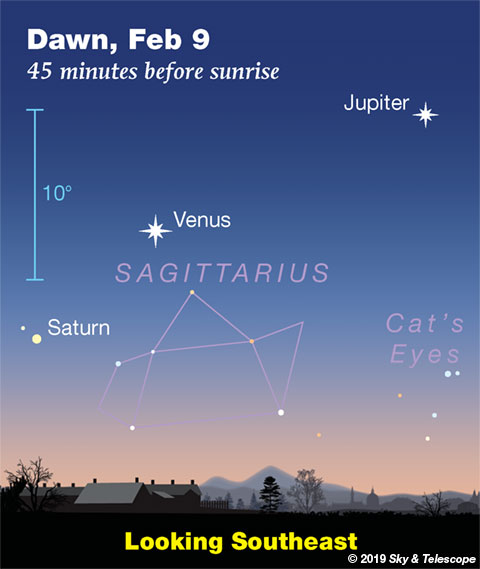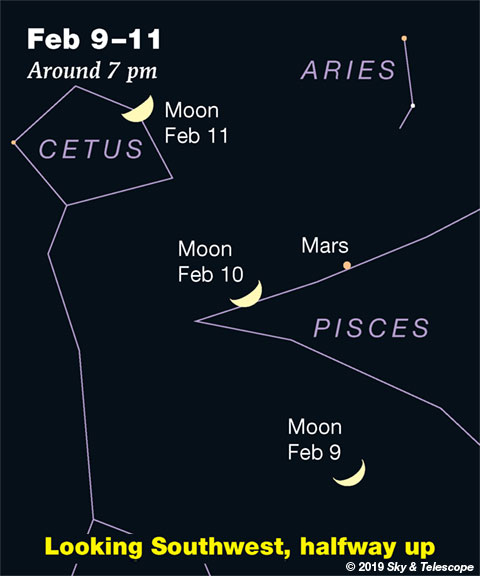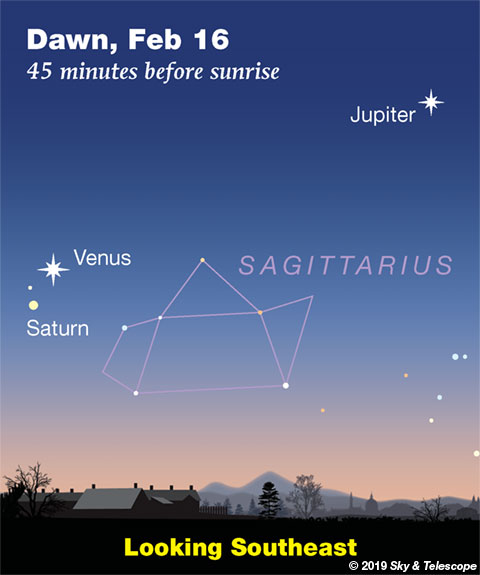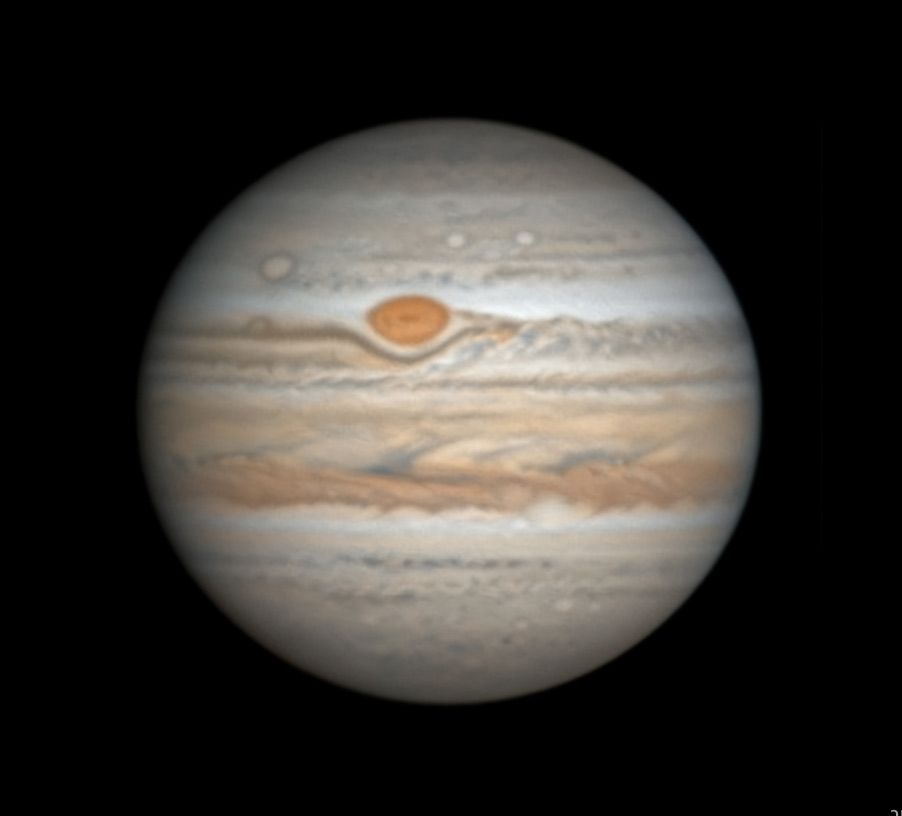Comet Iwamoto is 7th magnitude this week as it crosses Leo and Cancer high in the late-night sky. See Bob King's Comet Iwamoto Ascends and Brightens, with finder chart.


Friday, February 8
• The waxing crescent Moon shines in the west-southwest at nightfall. Above it by about two fists at arm's length is Mars, diminished far into the distance since its grand display last summer.
Saturday, February 9
• Now the Moon is about one fist below Mars right after dark. Look to the Moon's right for the dimmer Great Square of Pegasus, balancing on one corner.
• Under the feet of Orion hides Lepus the Hare. Like Canis Major, this constellation has a connect-the-dots pattern that really looks like what it's supposed to be. He's a crouching bunny, with his nose pointing lower right, his faint ears extending up toward Rigel (Orion's western foot), and his body bunched to the left.
His brightest two stars, 3rd-magnitude Beta and Alpha Leporis, form the front and back of his neck. At nightfall this week these two are straight below Rigel, by about one fist.
Sunday, February 10
• As twilight turns into night, the thick crescent Moon shines in the west-southwest. Spot little orange Mars to its right. Mars is actually twice as big as the Moon, but it's currently 620 times farther away.
Monday, February 11
• Mars and Uranus pass close by each other this evening through Wednesday evening. Mars is magnitude 1.0. Uranus is almost 100 times fainter at magnitude 5.8, but it's visible in binoculars nonetheless.
Right after nightfall tonight, find Mars to the lower right of the Moon. Uranus is located 1.2° to Mars's left and perhaps a touch higher. (For a sense of scale, a typical 8-power binocular has a field of view 6° or 7° wide.) To help orient yourself, you'll see the brighter star Omicron Piscium, magnitude 4.2, in the same binocular view a little farther below Uranus and a bit left.
• Meanwhile, late this evening for North America, 7th-magnitude Comet Iwamoto passes very close to Eta Leonis, magnitude 3.5, in Leo's Sickle. The timing of this passage is especially good for late-evening observers in the Eastern and Central time zones. See Comet Iwamoto Ascends and Brightens, with finder chart.
Tuesday, February 12
• First-quarter Moon (exact at 5:26 p.m. EST). The Moon shines below Aldebaran and the Pleiades. Mars is far to its lower right.
• Now you'll find Uranus is 1.0° left of Mars and perhaps a bit lower; see yesterday.
Wednesday, February 13
• The Moon, just past first quarter, shines in or near the Hyades this evening just a couple degrees from Aldebaran.
• Uranus is now 1.1° lower left of Mars right after dark. It's positioned less than halfway from Mars to Omicron Piscium, magnitude 4.2.
Thursday, February 14
• The waxing gibbous Moon this evening shines high over Orion, near the horn stars of Taurus.

Friday, February 15
• The Moon is in the feet of Gemini this evening. Castor and Pollux are to its left, Procyon is to its lower left, and Orion is to its lower right.
Saturday, February 16
• Right after dark, the gibbous Moon finds itself between Castor and Pollux to its upper right and Procyon farther to its lower left. By 10 or 11 p.m. this arrangement turns vertical.
• Partial asteroid occultation of Sirius coming. Late Monday night, the night of February 18-19, the brightest star in the night sky will be partially occulted for up to 1.8 seconds when, for well-placed observers, the invisibly tiny asteroid 4388 Jurgenstock momentarily passes in front of it. The occultation will happen along a very narrow path running from the Winnipeg area across the Dakotas, western Nebraska, eastern Colorado, New Mexico, northwestern Mexico, and possibly the tip of Baja California.
The asteroid is only about 4 miles wide, so it will subtend about the same angular diameter as Sirius, one of the nearest stars. That's why the occultation will almost surely be partial. Think videorecording!
The uncertainly in the path location is many times wider than the few miles of the path width itself, so you'll not only need to position yourself carefully, you'll also need a lot of luck. See full observing details and plans from David Dunham, and use this zoomable Google Map to choose your setup site. And check for a possible path update on Monday.
Also, here's Bob King's article about the event. I think the graphic there gives a false impression that the occultation has much chance of being anywhere near total for an observer even within the occultation track.
And remember, even if the occultation is total it will be so for only about 0.2 second, which (as King notes) to the eye may be similar to Sirius's twinkling. Sirius will already be fairly low as seen from North America, and the farther north you are the lower it will be. Which increases twinkling. You really do want to use videorecording for this.
________________________
Want to become a better astronomer? Learn your way around the constellations. They're the key to locating everything fainter and deeper to hunt with binoculars or a telescope.
This is an outdoor nature hobby. For an easy-to-use constellation guide covering the whole evening sky, use the big monthly map in the center of each issue of Sky & Telescope, the essential guide to astronomy.

Once you get a telescope, to put it to good use you'll need a detailed, large-scale sky atlas (set of charts). The basic standard is the Pocket Sky Atlas (in either the original or Jumbo Edition), which shows stars to magnitude 7.6.
Next up is the larger and deeper Sky Atlas 2000.0, plotting stars to magnitude 8.5; nearly three times as many. The next up, once you know your way around, are the even larger Interstellarum atlas (stars to magnitude 9.5) and Uranometria 2000.0 (stars to magnitude 9.75). And read how to use sky charts with a telescope.
You'll also want a good deep-sky guidebook, such as Sue French's Deep-Sky Wonders collection (which includes its own charts), Sky Atlas 2000.0 Companion by Strong and Sinnott, or the bigger Night Sky Observer's Guide by Kepple and Sanner.
Can a computerized telescope replace charts? Not for beginners, I don't think, and not on mounts and tripods that are less than top-quality mechanically (meaning heavy and expensive). And as Terence Dickinson and Alan Dyer say in their Backyard Astronomer's Guide, "A full appreciation of the universe cannot come without developing the skills to find things in the sky and understanding how the sky works. This knowledge comes only by spending time under the stars with star maps in hand."
This Week's Planet Roundup

Mercury is still deep in the sunset. But next week it'll emerge into a fine evening apparition.
Venus (magnitude –4.2, above the Sagittarius Teapot) and Jupiter (magnitude –1.9, in the feet of Ophiuchus) each rise well before the first glimmer of dawn. By the time dawn begins to brighten, they dominate the southeastern sky. (See the illustrations higher up.)
But they're ever farther apart, widening by 1° per day. On the morning of February 9th Jupiter is 17° upper right of Venus. By the 16th, it's 24° to Venus's upper right.
Look for twinkly orange Antares, magnitude +1.0, about 11° right of Jupiter.
In a telescope Venus is dazzling white and gibbous. Jupiter appears nearly twice as large in apparent diameter, but its surface brightness is some 50 times dimmer — due mostly to Jupiter's 7-times-greater distance from the illuminating Sun.
Mars (magnitude +1.0, at the Pisces-Aries border) glows high in the west-southwest at nightfall and sets around 11 p.m. In a telescope it's a tiny blob 6 arcseconds wide.
Saturn (magnitude +0.6) is emerging low in the glow of dawn, as shown at the top of this page. About 40 minutes before sunrise, use binoculars to look for it lower left of brilliant Venus.
They're closing in on each other; Saturn is 10° from Venus on February 9th, diminishing to 2° on the 16th.
Uranus (visible in binoculars at magnitude 5.8, at the Aries-Pisces border) is passing close by Mars this week. They'll be less than 1° apart from February 11th through 13th; see those dates above. Here's a finder chart (without Mars).
Neptune is out of sight, too low in the afterglow of sunset.
______________________
All descriptions that relate to your horizon — including the words up, down, right, and left — are written for the world's mid-northern latitudes. Descriptions that also depend on longitude (mainly Moon positions) are for North America.
Eastern Standard Time (EST) is Universal Time (UT or GMT) minus 5 hours.
______________________
Audio sky tour. Out under the evening sky with your earbuds in place, listen to Kelly Beatty's monthly podcast tour of the heavens above. It's free.
______________________
"Science is built up of facts, as a house is with stones. But a collection of facts is no more a science than a heap of stones is a house."
— Henri Poincaré (1854–1912)
______________________
 6
6








Comments
Rod
February 8, 2019 at 5:00 pm
Is mary-beth stargazing lately? Hopefully later tonight and early tomorrow morning I may be able to view comet C/2018 Y1 in Bob King's report. The comet will transit near 0233 EST at my location about 52 degrees altitude. I plan to view using my binoculars and telescope.
You must be logged in to post a comment.
mary beth
February 9, 2019 at 12:11 am
Hi Rod we have had cloudy weather all week and it’s been so depressing! I hate not seeing my stars… When it finally clears off they’ve moved so much I get confused LOL. I was thinking about you when I read this column this morning, I was hoping you could see Sirius’occultation later this week but I don’t think it will be visible to either of us. That’s exciting that you make it to see the comet in the morning, I’ll look for your report tomorrow! Hope you have clear skies!
You must be logged in to post a comment.
Rod
February 9, 2019 at 8:55 am
mary beth, I had clouds too last night. I did observe Mars and Uranus < 3 degrees apart thought using my 10x50 binoculars. Mars and Uranus will be 1 degree apart on 12-Feb-19. 08-Feb-19 near 1830 EST, "Tonight Mars and Uranus 2 deg 55' angular separation and I could see both planets in the binocular field of view, 10x50 binoculars. Mars distinct orange-red, Uranus somewhat light blue color. Mars in Pisces, Uranus in Aries. Cirrus clouds moved by and obscured viewing at times so no telescope used...Mars 87.92x brighter than Uranus tonight on the apparent magnitude scale."
You must be logged in to post a comment.
Rod
February 13, 2019 at 8:44 pm
mary beth, any stargazing reports from you? Tonight the skies cleared up for me (snow and rain last several days but temps near 2C) and I was out from 1830-1930 EST. The waxing gibbous Moon in Taurus sitting in the Hyades cluster tonight provided some great views using 10x50 binoculars and my telescope at 31x, wide field of view. In the telescope view I could see the south limb of the Moon with terminator line, various craters like Clavius crater along with Hyades stars below the south section of the Moon (could not fit entire Moon in FoV) like Theta1 and Theta 2 Tauri and some others near 6:00 position of the waxing gibbous Moon. With binoculars I could see Aldebaran with the Moon and other Hyades stars in the binocular field of view.
You must be logged in to post a comment.
mary beth
February 14, 2019 at 12:33 am
Hi Rod, we had ONE clear night last night, in about a 2-3 week period! It was stunning! Canopus was brilliantly twinkling low in the south right over my neighbors house, I enjoyed the first quarter moon until it set. Love seeing those Gemini twins arc across the sky. Orion’s tilt is quite fascinating too... especially since I haven’t been able to see it for so long. Isn’t there a four minute change each night in the position of each star? So even two weeks would be almost an hour?
Bet it was beautiful seeing all the stars near the moon! Reminds me of a cute little astronomy. I’ll share with you:
The moving Moon went up the sky,
And nowhere did abide;
Softly she was going up,
And a star or two beside.
–Samuel Taylor Coleridge (1772–1834)
You must be logged in to post a comment.
You must be logged in to post a comment.